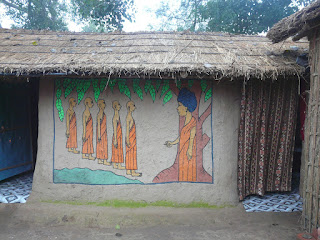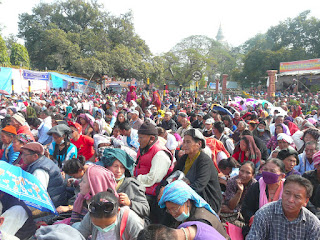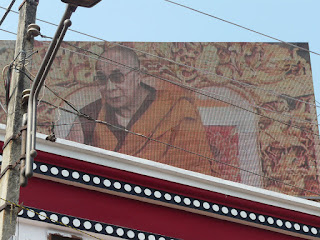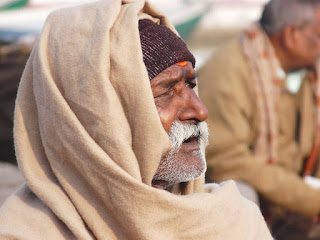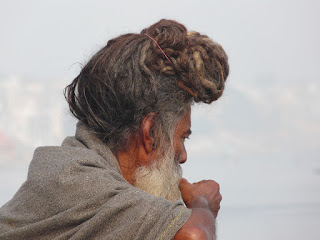However, the night train to Calcutta was late – as expected. Well, the bad fog again. But, at least, it was only 2 hours. Indeed, two extremely cold and windy hours in Varanasi railway station. There was a very nice railway official waiting with me. If it comes to trains delays, the rail often changes tracks in the last minutes before arrival. And from experience, the official told me, he knows that foreigners do not understand the announcements in the railway station… How true – Hindi we do not understand anyway, and Indian English over loudspeakers is not much better….
Well, with only 2 hours delay – there are no complaints about that.
 |
| Flower Market Calcutta |
We had more than enough time, as the journey should last 14 hours… Of course it took us longer, a bit less than 20 hours, but it was more or less comfortable, in the morning, we changed the beds into seats and early afternoon we arrived in Calcutta.
I have already been to Calcutta – but this was 16 years ago. At that time, I stayed in a hotel in Sudder Street in the city center. This is a really terrible area. 16 years back, this was very practical – centrally located, cheap and close to the house of mother Teresa where I worked for a few days. But a room for 50 cents cannot be a very nice one… To sum up, one can say about most hotels in this area: super cheap, but also super dirty, any kind of dead and living animals in the room, a lot of beggars in the streets, annoying shop assistants selling whatever, dubious travel agencies and restaurants with doubtful food, when it comes to hygiene, also lots of people using drugs. So, this area has a very bad reputation, and 16 years ago, I sometimes had the feeling, that I am more annoyed about my fellow travelers from all over the world than about the locals trying to make their living out of anything….
 No way, I would want to go back to Sudder Street! So, I did quite some
research before I left Germany and came across the youth hostel of
Calcutta. It is rather far outside of the city, but better travelling
each day for 25 minutes by metro and staying in a nice, quiet and clean
place than living in a hole in Sudder Street.When I saw the hostel I
knew exactly, that I my choice could not have been better. Nice room,
very clean, hot water, no dripping taps, good food and nice people
(staff and other guests) – just perfect!
No way, I would want to go back to Sudder Street! So, I did quite some
research before I left Germany and came across the youth hostel of
Calcutta. It is rather far outside of the city, but better travelling
each day for 25 minutes by metro and staying in a nice, quiet and clean
place than living in a hole in Sudder Street.When I saw the hostel I
knew exactly, that I my choice could not have been better. Nice room,
very clean, hot water, no dripping taps, good food and nice people
(staff and other guests) – just perfect!My very first day, I could not do a lot, as I arrived around 3 pm. And around 5.30pm it gets dark. Well, so, I took a tuktuk and went to Houghly River and by ferry to Belur Temple on the other side of the river. After the long train journey, I thought it might be nice to have a quiet hour in the temple and its surrounding park.
Well, for sure, it was different than I expected – exactly that day, there was the birthday of Ramakrishna Paramahamsa, the person, this temple is dedicated to. Ramakrishna was preaching for the unity of the religions and is rated as the creator of the modern Hinduism. All that was in 19th century. His ideas are still followed by many Indians, above all young people. So, there was not only a birthday party, but also a youth party at Belur Math Temple. Well, for sure, there were quite a few people and for sure, there was no way sitting somewhere in the garden enjoying the quietness of the place….
 |
| Calcutta |
In any case, a very exciting afternoon!
Returning to the youth hostel was nearly a little bit too exciting – actually, I wanted to go back by bus. However, because of all these parties going on in the whole area, busses were completely full. I mean completely full even by Indian standard! This means, people were hanging far outside the doors – and this not only one person… Getting "in" – no way, even getting one tenth of a foot on the platform of the full doors – not possible. At least not for me! Okay, a taxi then instead. But – also with this idea, I was not alone… Anyway, after some time, I got a taxi and then it took me only an hour to go back to the youth hostel. Well, that´s Calcutta – 5 kilometers in the taxi, in a brief hour….
 |
| Victoria Memorial, Calcutta |
Metro station Dum-Dum is a terminus. I never thought it would be a problem to enter a metro at a terminus. Well, each day, you learn something new – especially, when travelling. Usually, one might think, it should be possible to get at least a standing place in the metro…. Well, anyway, the first train – I just let it go, as there was no space to enter. With the second train, it was easier, as I stood relatively far in front. So, entering was possible. But, as I was one of the first to enter, I was quite far from the doors. Probably, you already assume, what happened, when I tried to leave…. I worked myself more towards the door, but on the last 2 meters, there were about 30 – 40 people blocking the door. So, at my stop Central, there was no way to get out!
Well, I tried it again a station later – this was easier, because there were other people, who wanted to get out as well!
Actually, I have seen cramped metros like that on TV, for example in Tokyo, but people there are probably not pushing others as much as here.
However, it was somehow funny, and whether I go 3 or 5 kilometers by taxi to my destination – this does not really matter!
Anyway – the flower market is worth the action! So many different colors, smells, nice people, so many men balancing huge loads on their heads, rickshaw drivers – basically very lively, very chaotic, very Indian…
People from Calcutta are very different from Indians in other cities. They are very interested in foreigners, but usually without the dollar sign in their eyes.
Besides, which tourist is going for any reason to Calcutta? This city still has got a bad reputation when it comes to its size, transport system, beggars, people who live on the street – in short, as author Günter Grass has said once: Calcutta is gods biggest shit hole!
 |
| Market in Calcutta |
But gods biggest shit hole? By no means. Calcutta is not only the Indian metropolis of the poor, but also of culture. There are a lot of galleries, where local and foreign artists show their works, the author and the first Indian Nobel Prize winner Rabindranath Tagore lived here (today, his house is a museum with great exhibits and a lot of photos from his life), then there is College Street with the biggest second-hand bookshop of the whole world. Astonishingly, you can find in these huts everything in literature – just perfect for the students of the nearby university.
 |
| Kumartuli, Calcutta |
In the palace, there are many marble statues from Europe. Many of them nude – nakedness in the country of Kamasutra and the erotic temple sculptures today is a scandal. Besides, there are Belgium glassware’s, Ming vases, chandeliers and mirrors – and paintings of Tizian and Rubens!
By far the most important place of interest and the pride of the locals is Victoria Memorial in the heart of town. The building is built out of white marble and is named after the British Queen. Today, Victoria Memorial houses a big museum – a lot of photos from the time of the construction, paintings of important personalities, miniatures, weapons….
The building is fascinating – but for me, the most exciting about Calcutta was its people, the colorful and busy streets, the markets and the normal life. For example, in Barabazar – claustrophobically narrow lanes, many small shops, market stalls lots of people out for shopping and men, who carry big loads on their heads or huge amount of goods in their carts.
 |
| Kumartuli, Calcutta |
This part of town is an oasis of quietness – I really enjoyed watching the artists doing their work – applying mud, pressing it flatly, wrapping in cloth and at the end painting the sculptures with shiny colors.
Sure, there are also many markets for colored cloths, scarfs, saris and Punjabis everywhere in town. On my last day, I wanted to spend my last Rupees on one of these markets. I thought about some scarfs, which are of better use in Germany than a sari would ever be… I am not a shopping person, but in this market it was really difficult to find something suitable.
However, right in the middle of this chaotic market, I saw a woman walking in front of me wearing a super nice scarf. Well, for sure, I asked her, where she got it from. Well, this was from a shop right at the other end of town… But we are in Calcutta, the town with the friendliest people of whole India. Well, what happened? We went in Rita’s big Mercedes and our own driver right to the other end of the city (which took us quite a while). There are very nice shops, mostly from Kashmiris. They usually have very nice goods, but are known as very good businessmen. Anyway, there was no reason to fear – I was with Rita, and all the talking and bargaining was done by her….
 |
| Riksha |
Well, good question – when I write these sentences, I am already back in good cold Germany and think exactly about that question. I fear, that my new friend Rita would not find that much spontaneity, friendliness and help in Europe or the US. But, actually, each of us can change that at least a little bit!
So, for the moment, this was the last newsletter from India. I hope you liked to travel with me through India.
We will see, what´s coming next and when.

